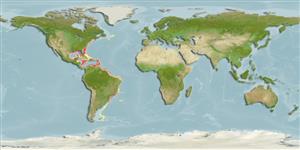Elasmobranquios (tiburones y rayas) (sharks and rays) >
Rajiformes (Skates and rays) >
Rajidae (Skates)
Etymology: Dactylobatus: Greek, daktyleys, -eos = a kind of grey mullet + Greek, batis = a kind of ray (Ref. 45335).
Eponymy: Dr Robert Selbie Clark (1882–1950) was a British marine zoologist and explorer who was a member of Shackleton’s Imperial Transantarctic Expedition (1914–1917), being one of those left on Elephant Island when Shackleton sailed in an open boat to [...] (Ref. 128868), visit book page.
Environment: milieu / climate zone / rango de profundidad / distribution range
Ecología
marino batidemersal; rango de profundidad 475 - 1000 m (Ref. 28767). Deep-water; 5°S - 31°N, 97°W - 33°W (Ref. 114953)
Western Central Atlantic: northern Gulf of Mexico (Ref. 13608) to South Carolina (Ref. 114953) and northern coast of South America (Ref. 5217).
Tamaño / Peso / Age
Madurez: Lm ? range ? - ? cm
Max length : 59.0 cm TL macho / no sexado; (Ref. 13608); 69.0 cm WD (female)
Inhabits mud-bottom habitat on the upper slope, generally in waters deeper than 350 meters. Mainly feeds on small bony fishes (Ref. 114953). Stomach contents include one specimen of Mullus argentinae, remains of a teleost fish and predominance of Myctophidae fishes. Sympatric with other chondrichthyans, Etmopterus bigelowi, Squalus aff. blainvillei, and Dipturus leptocauda (Ref. 56543). Oviparous (Ref. 50449). Eggs have horn-like projections on the shell (Ref. 205).
Life cycle and mating behavior
Madurez | Reproducción | Puesta | Huevos | Fecundidad | Larva
Oviparous, paired eggs are laid. Embryos feed solely on yolk (Ref. 50449). Eggs have horn-like projections on the shell (Ref. 205).
McEachran, J.D. and K.A. Dunn, 1998. Phylogenetic analysis of skates, a morphologically conservative clade of elasmobranchs (Chondrichthyes: Rajidae). Copeia 1998(2):271-290. (Ref. 27314)
IUCN Red List Status (Ref. 130435: Version 2025-1)
Threat to humans
Harmless
Human uses
Herramientas
Special reports
Download XML
Fuentes de Internet
Estimates based on models
Preferred temperature (Referencia
123201): 5.5 - 13, mean 8 °C (based on 76 cells).
Phylogenetic diversity index (Referencia
82804): PD
50 = 0.7500 [Uniqueness, from 0.5 = low to 2.0 = high].
Bayesian length-weight: a=0.00302 (0.00141 - 0.00645), b=3.24 (3.07 - 3.41), in cm total length, based on LWR estimates for this (Sub)family-body shape (Ref.
93245).
Nivel trófico (Referencia
69278): 4.5 ±0.80 se; based on food items.
Resiliencia (Referencia
120179): Bajo, población duplicada en un tiempo mínimo de 4.5-14 años (Fec assumed to be <100).
Fishing Vulnerability (Ref.
59153): Low vulnerability (22 of 100).
🛈
